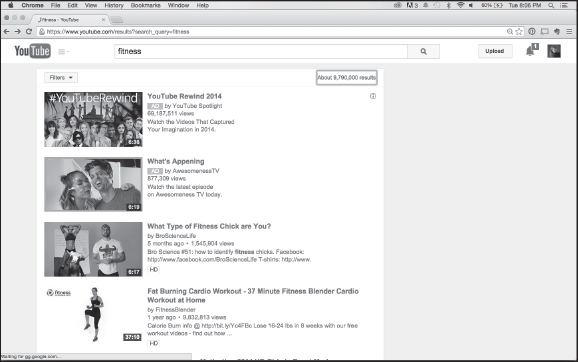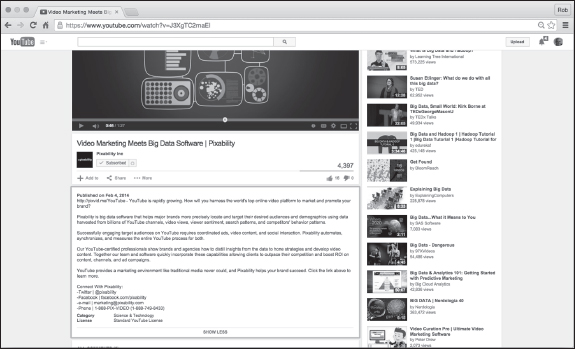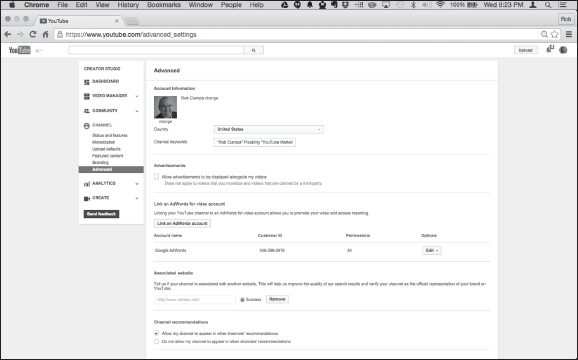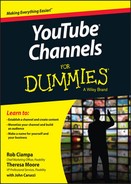Chapter 15
Ten Key Steps to Improving YouTube Search Results
In This Chapter
- Defining and optimizing video metadata
- Improving channel search results
- Avoiding misleading metadata
YouTube is about one thing: Getting people to watch your content. Before they watch it, though, they've got to find it. Simple, right? In theory, yes, but your challenge is to help viewers find your channel and your content. That's what search results are all about: Placing your content in front of the right viewers so that they can watch.
Unfortunately, YouTube doesn't share the secret sauce for getting found, but you can help improve the odds of your videos showing up in YouTube and Google Search as well as in Suggested Videos on the Watch page. To get that search engine to work for you, you need to optimize both your channel and your videos. It may come as a surprise to you, but YouTube cannot have a human watch all your videos to determine what topics they cover. To let YouTube understand what your videos are all about, then, you need to include metadata that describes the content for YouTube to index. (That's part of the optimization process.) In this chapter, we describe ten key steps for improving YouTube search results for your content.
Updating Video Metadata
Metadata are the words you use to describe your video — stuff like the video title, keyword tags, and video description. When uploading new content to your channel, YouTube walks you through the steps to add metadata. If you want to go back and tweak that metadata later, as part of your optimization strategy, do the following:
- Log in to your YouTube account.
- On your YouTube page, click the channel icon and then choose Creator Studio from the menu that appears.
- Click the Video Manager section of Creator Studio.
By default, it should go directly to the Videos submenu.
- Find the video and click the Edit button next to it.
- Modify the thumbnail, title, description, and tags to better reflect your optimization goals.
- When done, click the blue Save Changes button.
The two search results right under the ads in Figure 15-1 show good metadata — compelling thumbnail images, great titles, and punchy description data. Metadata helps visitors make viewing decisions, and good metadata helps visitors make better viewing decisions.

Figure 15-1: How YouTube video metadata shows up in search.
Managing Video Titles
Descriptive video titles are not only helpful for your viewers to identify content they may want to view but also important for YouTube's search engine. These titles are one key indicator used to index your videos. If you do nothing at all, at least be sure to use a keyword-rich title — a title full of descriptive words or adjectives, in other words. You always have the opportunity to rename your videos after you upload them to your channel. A good title tells the viewer what the content includes and who created the video, such as “Easy Stretches for Runners Led by Certified Yoga Instructor.”
 Good titles are 60 characters or fewer. Any longer and the title gets cut off in search results. Mobile devices often show even fewer characters before the title is cut off. If you have a large mobile audience, put the most important keywords at the beginning of the title so that they are visible to all users.
Good titles are 60 characters or fewer. Any longer and the title gets cut off in search results. Mobile devices often show even fewer characters before the title is cut off. If you have a large mobile audience, put the most important keywords at the beginning of the title so that they are visible to all users.
Understanding Working Titles
Editors — whether they're of the Hollywood variety or the YouTube variety — often use a working title for a film being edited. That's all fine and dandy in the privacy of your studio, but we're here to tell you that you should never upload an asset using a working title. Always upload your videos with a descriptive title — say, 2014 Napa Earth Quake Overview.mp4. Even if the descriptive title doesn't end up as the final title, it's important to have a descriptive title associated with the file. YouTube never loses this original upload title, so it always remains with your video file in YouTube's database. (This is simply another way to ensure that YouTube knows what your video is about, even if you forget to include any other metadata.)
Optimizing Thumbnails for Viewer Session Time
Thumbnails are visual snapshots of your video, similar to a poster for a movie. They have a tremendous impact on a video's view rate, so you should choose a good one. By default, YouTube chooses thumbnails from three optional frames taken at the beginning, middle, and end of your. You can, however, create a custom thumbnail for each video. If you do so, it's best to choose a thumbnail that is illustrative of the content in the video. Thumbnails show up in the following areas:
- Channel page
- Watch page
- Playlists
- Suggested videos
- Channel guide
- Subscriber feed
- YouTube search
- Web search
- Mobile display
- Mobile search
Although it's vital that the title of your video accurately reflects its content, it's even more important for a viewer's mobile viewing experience that you add a compelling video thumbnail. Users of mobile devices often base the decision of whether to watch your entire video on the appeal of the video thumbnail. The thumbnail should not confuse viewers; it should prepare them for the entire viewing experience. You can even create custom thumbnails for your playlists.
 Playlists can show up in YouTube searches along with the video results, and they often lead to longer viewing sessions. The longer a viewer's session time, the better it is for your video and channel ranking. Viewer session time is the primary ranking factor on YouTube's search engine.
Playlists can show up in YouTube searches along with the video results, and they often lead to longer viewing sessions. The longer a viewer's session time, the better it is for your video and channel ranking. Viewer session time is the primary ranking factor on YouTube's search engine.
Managing Video Descriptions
The video description is a 5,000-character field that YouTube provides you to describe your video. It's a great place to add details about not only your video but also your channel, along with links for other videos, subscriptions, other channels, and web assets. In other words, it's a goldmine for both metadata and user guidance. The viewers who care about your video will read the description, so make it worth their while.
The first two lines of the first paragraph of the description (approximately 100 characters) comprise the only element that shows in YouTube search results; thus, it's the most important part of the description copy. Everything to follow is consumed by YouTube's algorithms, and passionate followers who click the Show More link below the description copy. The first line should describe the content of the video and grab viewers' attention with alluring copy to lead them into the viewing experience. If you don't have a lot of time, focus your creative energy on the first paragraph.
The first line should also include a conversion link. The best practice is to include a short link to save space — you can compress any link using a link shortener like bit.ly, a free link-shortening website. The link might lead to a playlist with the video, the landing page on or off the YouTube site, a product page, or a blog. Figure 15-2 shows a good description.

Figure 15-2: YouTube video description copy.
 You can set up default metadata for your new uploads. Always remember to customize the title, tags and descriptions of every video. Your metadata should closely reflect each video's unique content.
You can set up default metadata for your new uploads. Always remember to customize the title, tags and descriptions of every video. Your metadata should closely reflect each video's unique content.
Adding Closed Captioning
YouTube and certain other platforms let you upload text files that contain closed-captioning subtitles for your video. You can then reach people who have hearing impairments, and it pays off for your search engine ranking. The captions are used by YouTube search to determine the topic of your video. (See Chapter 10 for information about adding captions.)
You don't have to write captions yourself. Several affordable services can create these caption files for you. 3Play Media (www.3playmedia.com), for example, provides captions for only dollars per minute.
Handling Tags
A tag is a keyword that identifies your video's content within YouTube for discovery. These unique, descriptive keywords are limited to 30 characters per keyword. Try to apply at least 15 tags per video, with a maximum of 500 characters per video. Tags are applied through the Video Manager portion of Creator Studio. You can add tags when you upload or modify them later on. Make the tags extremely relevant to your video content, and scatter them throughout the description copy. Start with the most specific tags first, to help viewers find your videos more easily when they're looking for a particular topic.
 Start off with specific keyword tags, but if you have space, then add some general purpose ones as well to identify the category of your video, such as beauty or DIY or entertainment.
Start off with specific keyword tags, but if you have space, then add some general purpose ones as well to identify the category of your video, such as beauty or DIY or entertainment.
Refreshing Metadata
Recently published videos typically rank higher in YouTube Search because they have newer content — though we're not saying that all old videos disappear. Older videos that have been watched frequently and are contextual matches for specific searches will rank well. It is important to revisit your older video content regularly and add in any new or trending metadata terms that are relevant.
 Refresh your annotations to link to newer, more relevant videos and playlists on your channel. (See Chapter 10 for information about annotation optimizations.)
Refresh your annotations to link to newer, more relevant videos and playlists on your channel. (See Chapter 10 for information about annotation optimizations.)
Understanding Channel SEO
Channels can show up in relevant YouTube searches along with video search results. You'll see a square channel icon and the first few lines of the channel description in the search results. To ensure that your channel appears in the search results, you have to let YouTube know what your channel is about. Your channel has a description field that you can use to communicate precisely what content viewers can find here. (See Chapter 9 for instructions on how to update and edit your channel description.)
A channel also has a field for keywords that you can use just like you use the Tags field for videos. To update your channel keywords:
- Log on to your YouTube account.
- On your YouTube page, click the channel icon and then choose Creator Studio from the menu that appears.
Doing so brings up the Creator Studio dashboard.
- Click the Channel heading in the navigation menu on the left.
- Click the Advanced button.
Doing so brings up a page dedicated to the advanced channel settings, as shown in Figure 15-3.
- Add relevant, descriptive keywords, separated by commas in the Channel Keyword field.
- When done, click the Save button.

Figure 15-3: YouTube channel metadata.
 Create a keyword-rich channel description. Craft an engaging first few lines of the channel description, because those are the elements that are revealed across YouTube with your channel.
Create a keyword-rich channel description. Craft an engaging first few lines of the channel description, because those are the elements that are revealed across YouTube with your channel.
 Add specific keywords first, and finish off with broader terms if space allows.
Add specific keywords first, and finish off with broader terms if space allows.
Avoiding Misleading Metadata
Using misleading or deceptive metadata is against YouTube policies. You cannot include metadata that isn't contextually relevant to your video content or that misrepresents the video's content. You cannot add a series of unrelated tags to your description copy to show up for additional search results. If Katy Perry isn't in your video, you shouldn't add her name to the title, tags, or description. Adding repetitive words in the description copy and tags indicates spam to YouTube and is disregarded.
 The most important thing is to not try to trick viewers into watching your content with misleading titles, thumbnails, tags, or description copy. These resources are at your disposal to add more contextual value to your video asset — not to fool viewers into clicking. Misleading metadata is a futile exercise. When viewers click on your video and don't find what they were looking for, they will click to go elsewhere quickly. This hurts your watchtime statistics and definitely hurts your search rankings. YouTube excels at detecting spam and misleading metadata, so trying to game the system will never succeed in the long run.
The most important thing is to not try to trick viewers into watching your content with misleading titles, thumbnails, tags, or description copy. These resources are at your disposal to add more contextual value to your video asset — not to fool viewers into clicking. Misleading metadata is a futile exercise. When viewers click on your video and don't find what they were looking for, they will click to go elsewhere quickly. This hurts your watchtime statistics and definitely hurts your search rankings. YouTube excels at detecting spam and misleading metadata, so trying to game the system will never succeed in the long run.
 Flag comments on videos if they look like spam. This helps YouTube improve its spam filters even further. Use the Flag for Spam feature only if you're confident that a comment is truly spam. If you're the owner of the content, you can remove or delete spam comments from your videos to help the viewer's engagement experience. Removing comments should be done only to create a better experience for your audience, not to control the conversation.
Flag comments on videos if they look like spam. This helps YouTube improve its spam filters even further. Use the Flag for Spam feature only if you're confident that a comment is truly spam. If you're the owner of the content, you can remove or delete spam comments from your videos to help the viewer's engagement experience. Removing comments should be done only to create a better experience for your audience, not to control the conversation.
